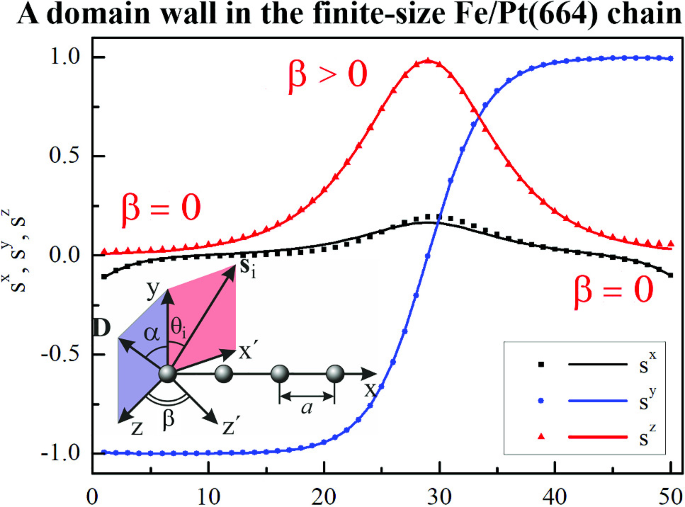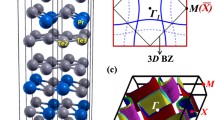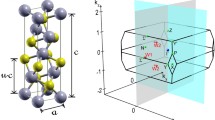Abstract
The energy barriers for magnetization reversal of the finite-size Fe chains on Pt(664) surface have been calculated using the geodesic nudged elastic band method. The Dzyaloshinskii–Moriya interaction and the dipole–dipole interaction have been taken into account. It has been found that the ground states of Fe/Pt(664) atomic chains are non-collinear at the ends. The magnetization reversal of short atomic chains occurs without the formation of the domain walls. While the magnetization reversal of the long atomic chains occurs via the formation of the domain walls. The interplay between the magnetic anisotropy energy and the Dzyaloshinskii–Moriya interaction leads to the rotation of the domain wall plane. As a result, the domain walls in Fe/Pt(664) atomic chains are intermediate configurations between Bloch and Néel walls. The dipole–dipole interaction weakly influences the value of the energy barriers and may be neglected. It is shown that the presented results can be explained in the framework of the classical continuous model. The constructed approximate functions correctly describe all features of the ground states and the saddle points. The structure of the domain walls and the dependencies of the energy barriers on the parameters of the model are different from the case of the Co/Pt(664) system investigated recently.
Graphical abstract




Similar content being viewed by others
Data availability statement
Data will be made available on reasonable request.
Notes
Here we neglect the symmetric anisotropic exchange interaction following to Ref. [30].
All angles are measured in radians.
More exact calculations of the critical temperature are beyond the scope of the paper.
The angle \(\beta \) is the same as the angle \(\phi _i\) in Fig. 1a. We use a different notation to emphasize that all magnetic moments in the domain wall lie in the same plane (\(\phi _i=\beta \) for all i).
The difference between the energy barriers is related to the inversion symmetry breaking.
Eq. (15) gives the value of \(\Delta N=5.080\) and \(N_0=4\Delta N\). Unfortunately, the direct comparison of \(\Delta N\) with the numerical results for the discrete model is not possible, because \(\Delta N\) is not integer. However, the good agreement between the GNEB results and theoretical approximation in Fig. 2 indicates that the estimation (15) of the \(\Delta N\) is quite well.
References
I. Zutic, J. Fabian, S. Das Sarma, Spintronics: fundamentals and applications. Rev. Mod. Phys. 76, 323–410 (2004). https://doi.org/10.1103/RevModPhys.76.323
D. Sander, The magnetic anisotropy and spin reorientation of nanostructures and nanoscale films. J. Phys. Condens. Matter 16(20), 603 (2004). https://doi.org/10.1088/0953-8984/16/20/R01
A. Enders, R. Skomski, J. Honolka, Magnetic surface nanostructures. J. Phys. Condens. Matter 22(43), 433001 (2010). https://doi.org/10.1088/0953-8984/22/43/433001
H. Wang, Y. Yu, Y. Sun, Q. Chen, Magnetic nanochains: a review. NANO 06(01), 1–17 (2011). https://doi.org/10.1142/S1793292011002305
N.D. Mermin, Quantum Computer Science: An Introduction (Cambridge University Press, Cambridge, 2007)
S. Bose, Quantum communication through an unmodulated spin chain. Phys. Rev. Lett. 91, 207901 (2003). https://doi.org/10.1103/PhysRevLett.91.207901
H. Verma, L. Chotorlishvili, J. Berakdar, S.K. Mishra, Qubit(s) transfer in helical spin chains. Europhys. Lett. 119(3), 30001 (2017). https://doi.org/10.1209/0295-5075/119/30001
H. Verma, L. Chotorlishvili, J. Berakdar, S.K. Mishra, Quantum teleportation by utilizing helical spin chains for sharing entanglement. Quantum Inf. Process. 20, 54 (2021). https://doi.org/10.1007/s11128-020-02971-4
M. Kaczor, I. Tralle, P. Jakubczyk, S. Stagraczynski, L. Chotorlishvili, Switching of the information backflow between a helical spin system and non-Markovian bath. Ann. Phys. 442, 168918 (2022). https://doi.org/10.1016/j.aop.2022.168918
D.-J. Choi, N. Lorente, J. Wiebe, K. von Bergmann, A.F. Otte, A.J. Heinrich, Colloquium: atomic spin chains on surfaces. Rev. Mod. Phys. 91, 041001 (2019). https://doi.org/10.1103/RevModPhys.91.041001
A.G. Syromyatnikov, S.V. Kolesnikov, A.M. Saletsky, A.L. Klavsyuk, Formation and properties of metallic atomic chains and wires. Phys. Usp. 64(7), 671–701 (2021). https://doi.org/10.3367/UFNe.2020.06.038789
J. Shen, J.P. Pierce, E.W. Plummer, J. Kirschner, The effect of spatial confinement on magnetism: films, stripes and dots of fe on cu(111). J. Phys. Condens. Matter 15(2), 1 (2002). https://doi.org/10.1088/0953-8984/15/2/201
J. Shen, R. Skomski, M. Klaua, H. Jenniches, S.S. Manoharan, J. Kirschner, Magnetism in one dimension: Fe on cu(111). Phys. Rev. B 56, 2340–2343 (1997). https://doi.org/10.1103/PhysRevB.56.2340
P. Gambardella, A. Dallmeyer, K. Maiti, M.C. Malagoli, W. Eberhardt, K. Kern, C. Carbone, Ferromagnetism in one-dimensional monatomic metal chains. Nature 416, 301 (2002). https://doi.org/10.1038/416301a
P. Gambardella, S. Rusponi, M. Veronese, S.S. Dhesi, C. Grazioli, A. Dallmeyer, I. Cabria, R. Zeller, P.H. Dederichs, K. Kern, C. Carbone, H. Brune, Giant magnetic anisotropy of single cobalt atoms and nanoparticles. Science 300(5622), 1130–1133 (2003). https://doi.org/10.1126/science.1082857
A.G. Syromyatnikov, S.V. Kolesnikov, A.M. Saletsky, A.L. Klavsyuk, The structure phase transition in atom-wide co wires on a vicinal Cu111 surface. Mater. Lett. 179, 69–72 (2016). https://doi.org/10.1016/j.matlet.2016.05.024
P. Gambardella, A. Dallmeyer, K. Maiti, M.C. Malagoli, S. Rusponi, P. Ohresser, W. Eberhardt, C. Carbone, K. Kern, Oscillatory magnetic anisotropy in one-dimensional atomic wires. Phys. Rev. Lett. 93, 077203 (2004). https://doi.org/10.1103/PhysRevLett.93.077203
B. Dupé, J.E. Bickel, Y. Mokrousov, F. Otte, K. von Bergmann, A. Kubetzka, S. Heinze, R. Wiesendanger, Giant magnetization canting due to symmetry breaking in zigzag co chains on ir(001). New J. Phys. 17(2), 023014 (2015). https://doi.org/10.1088/1367-2630/17/2/023014
O. Gomonay, V. Baltz, A. Brataas, Y. Tserkovnyak, Antiferromagnetic spin textures and dynamics. Nat. Phys. 14, 213–216 (2018). https://doi.org/10.1038/s41567-018-0049-4
V. Baltz, A. Manchon, M. Tsoi, T. Moriyama, T. Ono, Y. Tserkovnyak, Antiferromagnetic spintronics. Rev. Mod. Phys. 90, 015005 (2018). https://doi.org/10.1103/RevModPhys.90.015005
T. Jungwirth, X. Marti, P. Wadley, J. Wunderlich, Antiferromagnetic spintronics. Nat. Nanotechnol. 11, 231–241 (2016). https://doi.org/10.1038/nnano.2016.18
I. Dzyaloshinsky, A thermodynamic theory of “weak’’ ferromagnetism of antiferromagnetics. J. Phys. Chem. Solids 4(4), 241–255 (1958). https://doi.org/10.1016/0022-3697(58)90076-3
T. Moriya, New mechanism of anisotropic super exchange interaction. Phys. Rev. Lett. 4, 228–230 (1960). https://doi.org/10.1103/PhysRevLett.4.228
H.T. Nembach, J.M. Shaw, M. Weiler, E. Jué, T.J. Silva, Linear relation between Heisenberg exchange and interfacial Dzyaloshinskii–Moriya interaction in metal films. Nat. Phys. 11, 825–829 (2015). https://doi.org/10.1038/nphys3418
J. Cho, N.-H. Kim, S. Lee, J.-S. Kim, R. Lavrijsen, A. Solignac, Y. Yin, D.-S. Han, N.J.J. van Hoof, H.J.M. Swagten, B. Koopmans, C.-Y. You, Thickness dependence of the interfacial Dzyaloshinskii–Moriya interaction in inversion symmetry broken systems. Nat. Commun. 6, 7635 (2015). https://doi.org/10.1038/ncomms8635
Y. Mokrousov, A. Thiess, S. Heinze, Structurally driven magnetic state transition of biatomic fe chains on ir(001). Phys. Rev. B 80, 195420 (2009). https://doi.org/10.1103/PhysRevB.80.195420
R. Mazzarello, E. Tosatti, Connection between magnetism and structure in Fe double chains on the ir(100) surface. Phys. Rev. B 79, 134402 (2009). https://doi.org/10.1103/PhysRevB.79.134402
M. Menzel, Y. Mokrousov, R. Wieser, J.E. Bickel, E. Vedmedenko, S. Blügel, S. Heinze, K. von Bergmann, A. Kubetzka, R. Wiesendanger, Information transfer by vector spin chirality in finite magnetic chains. Phys. Rev. Lett. 108, 197204 (2012). https://doi.org/10.1103/PhysRevLett.108.197204
M. Heide, G. Bihlmayer, S. Blügel, Dzyaloshinskii–Moriya interaction accounting for the orientation of magnetic domains in ultrathin films: Fe/w(110). Phys. Rev. B 78, 140403 (2008). https://doi.org/10.1103/PhysRevB.78.140403
B. Schweflinghaus, B. Zimmermann, M. Heide, G. Bihlmayer, S. Blügel, Role of Dzyaloshinskii–Moriya interaction for magnetism in transition-metal chains at pt step edges. Phys. Rev. B 94, 024403 (2016). https://doi.org/10.1103/PhysRevB.94.024403
L. Chotorlishvili, X.-G. Wang, A. Dyrdal, G.-H. Guo, V.K. Dugaev, J. Barnas, J. Berakdar, Rectification of the spin seebeck current in noncollinear antiferromagnets. Phys. Rev. B 106, 014417 (2022). https://doi.org/10.1103/PhysRevB.106.014417
M. Heide, G. Bihlmayer, S. Blugel, Non-planar Dzyaloshinskii spirals and magnetic domain walls in non-centrosymmetric systems with orthorhombic anisotropy. J. Nanosci. Nanotechnol. 11, 3005–3015 (2011). https://doi.org/10.1166/jnn.2011.3926
K.J.A. Franke, C. Ophus, A.K. Schmid, C.H. Marrows, Switching between magnetic Bloch and néel domain walls with anisotropy modulations. Phys. Rev. Lett. 127, 127203 (2021). https://doi.org/10.1103/PhysRevLett.127.127203
L. Sánchez-Tejerina, O. Alejos, E. Martínez, J.M. Muñoz, Asymmetric driven dynamics of Dzyaloshinskii domain walls in ultrathin ferromagnetic strips with perpendicular magnetic anisotropy. J. Magn. Magn. Mater. 409, 155–162 (2016). https://doi.org/10.1016/j.jmmm.2016.02.067
S. Rohart, A. Thiaville, Skyrmion confinement in ultrathin film nanostructures in the presence of Dzyaloshinskii–Moriya interaction. Phys. Rev. B 88, 184422 (2013). https://doi.org/10.1103/PhysRevB.88.184422
S.V. Kolesnikov, E.S. Sapronova, I.N. Kolesnikova, An influence of the Dzyaloshinskii–Moriya interaction on the magnetization reversal process of the finite-size co chains on pt(664) surface. J. Magn. Magn. Mater. 579, 170869 (2023). https://doi.org/10.1016/j.jmmm.2023.170869
L. Udvardi, L. Szunyogh, K. Palotás, P. Weinberger, First-principles relativistic study of spin waves in thin magnetic films. Phys. Rev. B 68, 104436 (2003). https://doi.org/10.1103/PhysRevB.68.104436
J. Hermenau, S. Brinker, M. Marciani, M. Steinbrecher, M. dos Santos Dias, R. Wiesendanger, S. Lounis, J. Wiebe, Stabilizing spin systems via symmetrically tailored RKKY interactions. Nat. Commun. 10, 2565 (2019). https://doi.org/10.1038/s41467-019-10516-2
W. Kohn, Nobel lecture: electronic structure of matter–wave functions and density functionals. Rev. Mod. Phys. 71, 1253–1266 (1999). https://doi.org/10.1103/RevModPhys.71.1253
H. Ebert, D. Ködderitzsch, J. Minár, Calculating condensed matter properties using the KKR-green’s function method-recent developments and applications. Rep. Prog. Phys. 74(9), 096501 (2011). https://doi.org/10.1088/0034-4885/74/9/096501
L.D. Landau, E.M. Lifshitz, On the theory of the dispersion of magnetic permeability in ferromagnetic bodies. Phys. Z. Sowjet. 8, 153 (1935)
Y. Li, B.-G. Liu, Long-range ferromagnetism in one-dimensional monatomic spin chains. Phys. Rev. B 73, 174418 (2006). https://doi.org/10.1103/PhysRevB.73.174418
S.V. Kolesnikov, I.N. Kolesnikova, Improved kinetic Monte Carlo models for computational and analytical investigations of the magnetic properties of finite-size atomic chains. Europhys. Lett. 137(5), 56003 (2022). https://doi.org/10.1209/0295-5075/ac5b20
S.V. Kolesnikov, Low-temperature study of the magnetic properties of finite atomic chains. JETP Lett. 103, 588–592 (2016). https://doi.org/10.1134/S0021364016090034
S.V. Kolesnikov, I.N. Kolesnikova, An estimate for the magnetization reversal time of antiferromagnetic chains within the Heisenberg model. J. Exp. Theor. Phys. 125, 644 (2017). https://doi.org/10.1134/S1063776117090060
S.V. Kolesnikov, I.N. Kolesnikova, Magnetic properties of the finite-length biatomic chains in the framework of the single domain-wall approximation. Phys. Rev. B 100, 224424 (2019). https://doi.org/10.1103/PhysRevB.100.224424
P. Hänggi, P. Talkner, M. Borkovec, Reaction-rate theory: fifty years after Kramers. Rev. Mod. Phys. 62, 251–341 (1990). https://doi.org/10.1103/RevModPhys.62.251
P.F. Bessarab, V.M. Uzdin, H. Jónsson, Method for finding mechanism and activation energy of magnetic transitions, applied to Skyrmion and antivortex annihilation. Comput. Phys. Commun. 196, 335–347 (2015). https://doi.org/10.1016/j.cpc.2015.07.001
I.S. Lobanov, M.N. Potkina, V.M. Uzdin, Stability and lifetimes of magnetic states of nano- and microstructures (brief review). JETP Lett. 113, 801–813 (2021). https://doi.org/10.1134/S0021364021120109
S.V. Kolesnikov, E.S. Sapronova, Influence of Dzyaloshinskii–Moriya and dipole-dipole interactions on spontaneous magnetization reversal time of finite-length co chains on pt(664) surfaces. IEEE Magn. Lett. 13, 1–5 (2022). https://doi.org/10.1109/LMAG.2022.3226656
B. Lazarovits, L. Szunyogh, P. Weinberger, B. Újfalussy, Magnetic properties of finite Fe chains at fcc cu(001) and cu(111) surfaces. Phys. Rev. B 68, 024433 (2003). https://doi.org/10.1103/PhysRevB.68.024433
S. Pick, P.A. Ignatiev, A.L. Klavsyuk, W. Hergert, V.S. Stepanyuk, P. Bruno, Structure and magnetic properties of Co chains on a stepped Cu surface. J. Phys. Condens. Matter 19(44), 446001 (2007). https://doi.org/10.1088/0953-8984/19/44/446001
E.M. Chudnovsky, L. Gunther, Quantum tunneling of magnetization in small ferromagnetic particles. Phys. Rev. Lett. 60, 661–664 (1988). https://doi.org/10.1103/PhysRevLett.60.661
W. Wernsdorfer, R. Clérac, C. Coulon, L. Lecren, H. Miyasaka, Quantum nucleation in a single-chain magnet. Phys. Rev. Lett. 95, 237203 (2005). https://doi.org/10.1103/PhysRevLett.95.237203
A.S. Smirnov, N.N. Negulyaev, W. Hergert, A.M. Saletsky, V.S. Stepanyuk, Magnetic behavior of one- and two-dimensional nanostructures stabilized by surface-state electrons: a kinetic Monte Carlo study. New J. Phys. 11(6), 063004 (2009). https://doi.org/10.1088/1367-2630/11/6/063004
N.S. Kabanov, R. Heimbuch, H.J.W. Zandvliet, A.M. Saletsky, A.L. Klavsyuk, Atomic structure of self-organizing iridium induced nanowires on ge(001). Appl. Surf. Sci. 404, 12–17 (2017). https://doi.org/10.1016/j.apsusc.2017.01.206
L.D. Landau, E.M. Lifshitz, Electrodynamics of Continuous Media (Pergamon Press, New York, 1960)
R. Rajaraman, Solitons and Instantons. An Introduction to Solitons and Instantons in Quantum Field Theory (North-Holland Publishing Company, Amsterdam, 1982)
V. Sadovnichy, A. Tikhonravov, V. Voevodin, V. Opanasenko, “lomonosov”: supercomputing at Moscow State University, in Contemporary High Performance Computing: From Petascale Toward Exascale (CRC Press, Boca Raton, USA, 2013), pp. 283–307
V.V. Voevodin, A.S. Antonov, D.A. Nikitenko, P.A. Shvets, S.I. Sobolev, I.Y. Sidorov, K.S. Stefanov, V.V. Voevodin, S.A. Zhumatiy, Supercomputer lomonosov-2: large scale, deep monitoring and fine analytics for the user community. Supercomput. Front. Innov. 6(2), 4–11 (2019). https://doi.org/10.14529/jsfi190201
Acknowledgements
The research is carried out using the equipment of the shared research facilities of HPC computing resources at Lomonosov Moscow State University [59, 60]. The investigation is supported by the Russian Science Foundation (Project No 21-72-20034). E.S. Sapronova also acknowledges financial support of the Theoretical Physics and Mathematics Advancement Foundation “BASIS”.
Author information
Authors and Affiliations
Contributions
All the authors contributed equally to the paper.
Corresponding author
Rights and permissions
Springer Nature or its licensor (e.g. a society or other partner) holds exclusive rights to this article under a publishing agreement with the author(s) or other rightsholder(s); author self-archiving of the accepted manuscript version of this article is solely governed by the terms of such publishing agreement and applicable law.
About this article
Cite this article
Kolesnikov, S.V., Sapronova, E.S. & Kolesnikova, I.N. Ground and excited states of the finite-size Fe chains on Pt(664) surface. Eur. Phys. J. B 96, 163 (2023). https://doi.org/10.1140/epjb/s10051-023-00634-8
Received:
Accepted:
Published:
DOI: https://doi.org/10.1140/epjb/s10051-023-00634-8




